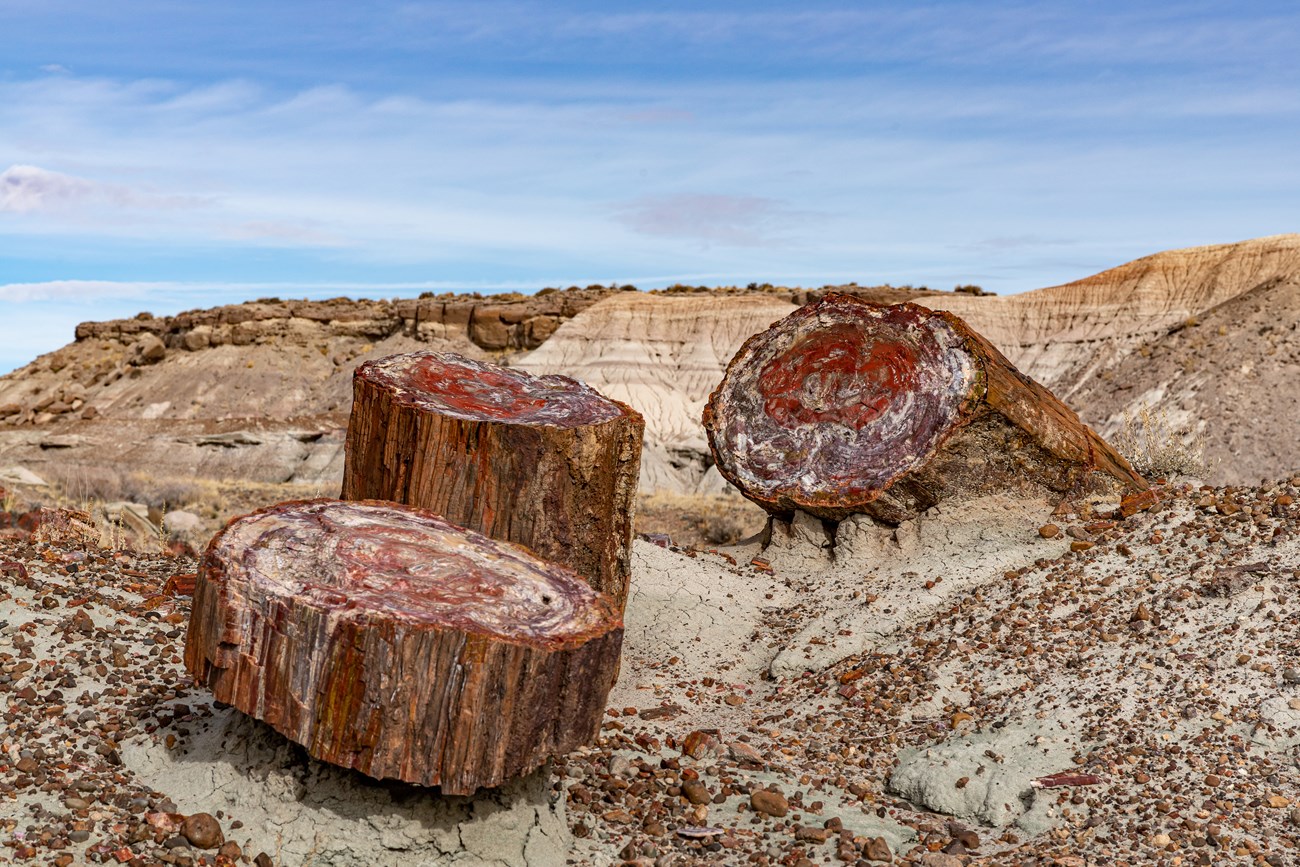[Site Under Development]

NPS photo by Jacob Holgerson.
Introduction
Plants are one of the most abundant and diverse groups of organisms on Earth. Like fungi, protists, invertebrates, and vertebrates, plants are eukaryotes. What distinguishes them from these other groups are rigid cell walls around each cell and their ability to produce their own food by capturing light and converting it into sugar, starch, and other foods needed for survival. Some fossils that appear to be from plants date back to the Ordovician, but the first unquestioned occurrences of plant fossils are from the Late Silurian.
The study of fossil plants is known as paleobotany. Paleobotany is an important aspect of paleontology especially useful for understanding and interpreting ancient ecosystems. Fossil plants range from the most delicate of flowers to the largest of petrified trees and stumps, and include nearly every other part of a plant: leaves, roots, nuts, cones, berries, needles, stems, twigs, seeds, and pollen.
Types of Plants
To learn more, select a type of plant:
While walking through a bog or along a stream bank, you may have pulled apart the finely ribbed stems of horsetails or scouring rushes at their joints. These jointed plants and their relatives have whorls of leaves or branches at the stem joints. Much smaller today, they once grew like trees in coal-forming swamps during the Pennsylvanian Period, though they appeared during the Devonian Period. You can find fossil horsetails at Grand Canyon and Petrified Forest national parks in Arizona and New River Gorge National River in West Virginia.
Although many ferns are low herbaceous plants, they have periodically attained the dimensions of trees; forests of such tree ferns exist today in humid regions such as New Zealand. Large ferns were present as early as the Late Devonian and different genera as large or larger were significant components of forests during the Pennsylvanian Period. The Pennsylvanian Hermit Shale in Grand Canyon National Park in Arizona preserves many fossil ferns as does the Jurassic Morrison Formation at Dinosaur National Monument in Colorado and Utah.
The best known conifer fossils in the National Park System are the large silicified logs in Petrified National Park in Arizona. Florissant Fossil Beds National Monument and Yellowstone National Park also have extraordinary examples of petrified trees and wood. More recent conifer specimens in the National Park System include an 800,000-year-old pinecone from Valley Forge National Historical Park in Pennsylvania.
During the Triassic, Jurassic, and Cretaceous periods, forests contained large numbers of trees and shrubby plants that looked like palm trees, with large divided leaves and pineapple-like trunks. These were cycads. Cycads had their heyday during the Mesozoic Era, but a small number of cycads survive in tropical and subtropical regions today. Petrified Forest, Arches, and Canyonlands national parks contain cycad fossils, but they are much less conspicuous in the National Park System today than they were in the 1920s and 1930s at Fossil Cycad National Monument.
Related Links
A good deal of angiosperm diversification probably happened within the last 120 million years. The first known fossils are from the Cretaceous Period, and this group has living relatives. Flower fossils are extremely beautiful, for example from Florissant Fossil Beds National Monument. The Eocene lake deposits at Fossil Butte National Monument in Wyoming also contain fossil flowers, and fossilized cattails are on display at the visitor center there.
Earliest Plants on Land
Rocks from the Ordovician Period contain evidence that plants began colonizing dry land at this time. Most experts agree that the ancestors of land plants first evolved in a marine environment, then moved into a freshwater environment and finally onto land.First flowering plants
Angiosperms (flowering plants) appeared in the fossil record more than 100 million years ago during the Cretaceous Period. Once they appeared, they quickly became the dominant type of plant life on land and remain so today. The earliest angiosperms evolved from a specialized group of seed ferns. Since their first appearance, angiosperms have adapted to nearly every terrestrial habitat from mountains to deserts, and some have adapted to shallow coastal waters. A few varieties are known as “carnivorous” plants.
Not all flowering plants produce the kinds of blossoms you find in florist shops, but along with enclosed seeds, flowers are a key reproductive feature of angiosperms. The evolution of flowers, which attract pollinators, especially insects, and the evolution of a seed, with a protective coating and a ready supply of nourishment, enabled flowering plants to populate the world. Angiosperm seeds are dispersed widely in many ways: blown by the wind, transported by rivers and streams, carried in burrs that become attached to animal fur (or your socks), or embedded in fleshy fruit that is eaten and later “pooped out.”
Angiosperms have developed an incredible array of colors, scents, and fruits through their intricate and reciprocal relationship with the animal world. Without the abundance and variety of flowering plants (more than 90% of all land-plant species) known today, the world would be a much duller place.
Related Stories
Featured Parks
-
Chaco Culture National Historical Park (CHCU), New Mexico—[CHCU Geodiversity Atlas] [CHCU Park Home] [CHCU npshistory.com]
-
Florissant Fossil Beds National Monument (FLFO), Colorado—[FLFO Geodiversity Atlas] [FLFO Park Home] [FLFO npshistory.com]
-
Fossil Butte National Monument (FOBU), Wyoming—[FOBU Geodiversity Atlas] [FOBU Park Home] [FOBU npshistory.com]
-
Hawai’i Volcanoes National Park (HAVO), Hawai’i—[HAVO Geodiversity Atlas] [HAVO Park Home] [HAVO npshistory.com]
-
Petrified Forest National Park (PEFO), Arizona—[PEFO Geodiversity Atlas] [PEFO Park Home] [PEFO npshistory.com]
-
Prince William Forest Park (PRWI), Virginia—[PRWI Geodiversity Atlas] [PRWI Park Home] [PRWI npshistory.com]
-
Yellowstone National Park (YELL), Idaho, Montana, and Wyoming—[YELL Geodiversity Atlas] [YELL Park Home] [YELL npshistory.com]
Last updated: December 11, 2024
